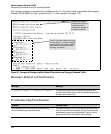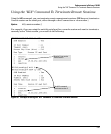
132
Enhancements in Release F.04.08
Configuring Port-Based Priority for Incoming Packets
Configuring Port-Based Priority for Incoming Packets
When network congestion occurs, it is important to move traffic on the basis of relative importance.
However, without prioritization:
■ Traffic from less important sources can consume bandwidth and slow down or halt delivery
of more important traffic.
■ Most traffic from all ports is forwarded as normal priority, and competes for bandwidth with
all other normal-priority traffic, regardless of its relative importance.
Traffic received in tagged VLAN packets carries a specific 802.1p priority level (0 - 7) that the switch
recognizes and uses to assign packet priority at the outbound port. With the default port-based
priority, the switch handles traffic received in untagged packets as "Normal" (priority level = 0).
You can assign a priority level to inbound, untagged VLAN packets. (The switch does not alter the
priority level of 802.1p tagged VLAN packets it receives.) Thus, for example, high-priority tagged
VLAN traffic received on a port retains its priority in the switch. However, you have the option of
configuring the port to assign a priority level to untagged VLAN traffic the port receives.
The Role of 802.1Q VLAN Tagging
An 802.1Q-tagged VLAN packet carries the packet’s VLAN assignment and the 802.1p priority setting
(0 - 7). (By contrast, an untagged packet does not have a tag and does not carry a priority setting.)
Generally, the switch preserves and uses a packet’s priority setting to determine which outbound
queue the packet belongs in on the outbound port. If the outbound port is a tagged member of the
VLAN, the packet carries its original priority to the next, downstream device. If the outbound port is
not configured as a tagged member of the VLAN, then the tag is stripped from the packet, which then
exits from the switch without a priority setting.
Feature Default Menu CLI Web
Assigning a priority level to traffic on the basis
of incoming port
Disabled n/a page 134 n/a


















